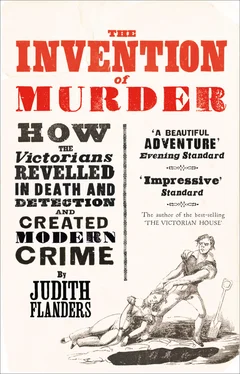The next person to handle Aram’s story was the most influential. Bulwer, fresh from his triumphs with crime and criminals in Pelham and Paul Clifford, in 1832 took on Eugene Aram. Bulwer begins his story in Grassdale, where Aram, a reclusive scholar-genius, falls in love with Madeline Lester, the squire’s daughter. All are pleased except her cousin Walter, who is in love with Madeline himself, and who now travels to forget. In a saddler’s shop in the north, he recognizes his long-vanished father’s whip. But he is told it was owned by a man named Daniel Clark, a villain who was later murdered. Walter meets Houseman, who incautiously connects Clark’s murder to Aram.Walter thunders home to prevent the wedding of his cousin to a murderer, Aram is arrested, tried and convicted, and Madeline dies of grief. Aram confesses: he was ‘haunted with the ambition of enlightening my race’, but was prevented from making ‘a gigantic discovery in science’ by ‘the total inadequacy of my means’. He decided, therefore, that it was ‘better for mankind – that I should commit one bold wrong, and by that wrong purchase the power of good’. His crime was further diminished: Clark was a vicious aristocrat who had raped a ‘quiet, patient-looking, gentle creature’, who subsequently killed herself. Aram’s repentance, such as it is, entirely revolves around the shame he has brought to the noble family of Lester, out of remorse for which he then commits suicide.
Bulwer aimed to make Aram a tragic figure: a noble man destroyed by a single flaw. To do so he had to rewrite almost all the known facts, apart from the long-undiscovered crime itself. *Clark, instead of a young labouring man, is now, melodrama-fashion, an upper-class despoiler of women; Aram’s abandoned wife and half-dozen children vanish without a trace; while Aram himself is no longer a humble usher, but a scholar of international renown.
This fiction quickly displaced fact. In 1832, the Trial and Life of Eugene Aram; several of his Poems, and his plan and specimens of an Anglo-Celtic Lexicon, with copious notes … worked backwards from the novel, using Bulwer’s fictional account of the trial as though it were a verbatim court report. The Leeds Mercury commented admiringly on Aram as ‘a man of most extraordinary talents and character’, and the Gentleman’s Magazine agreed that he was entirely innocent. It was widely reported that Archdeacon Paley had pronounced Aram’s defence to be one ‘of consummate ability’. (A modern scholar has noted that Paley was an adolescent at the time, so if he had made the remark at all, it wasn’t a hugely mature judgement; later in life he said that Aram had ‘got himself hanged by his own cleverness’.) The journalist Leigh Hunt went even further in his praise: ‘Had Johnson been about him, the world would have attributed the defence to Johnson.’ Bulwer’s biographer later claimed that Bulwer’s creation, Madeline Lester, was also based on reality, ‘taken word for word, fact for fact, from Burney’s notes’. As Burney had been eight years old at the time, we might assume that his memories of an impoverished usher yearning after the local squire’s daughter might not be terribly reliable, if they ever existed.
Of the success of Bulwer’s novel, however, there could be no doubt. Within its first year, the Morning Chronicle noted, as well as French and German translations, the book sold over 30,000 copies in the USA. The Hampshire Telegraph and Sussex Chronicle published a plea from the Library and Reading Room in Queen Street, Portsea, in which it ‘earnestly requested that their subscribers who have [borrowed] the first volumes … of Eugene Aram … will return them forthwith. as detaining them so long prevents that accomodation [sic] which they wish should be received by all’.
Others rushed to elaborate the subject. Although he would have been disgusted to have his work categorized as fiction, there is nowhere else to put Norrisson Scatcherd’s highly coloured Memoirs of the Celebrated Eugene Aram … Scatcherd, a barrister who devoted his life to antiquarian and local-history research, claimed to have become interested in Aram in 1792, when he was about twelve, on a visit to Harrogate, and he says it was then that he began to interview locals who had known Aram thirty-three years before. In his version, Aram was ‘modest’, ‘amiable’, ‘beloved and admired’. His wife, however, was ‘a low, mean, vulgar woman, of extremely doubtful character’, who was unfaithful, and thus Aram’s doubts of their children’s paternity made it perfectly natural that he should be ‘disposed. to neglect them’. According to Scatcherd, Clark was Mrs Aram’s lover, and in addition he and Houseman were planning to rob and kill a pedlar boy. Aram helped Clark dishonestly order plate and goods, but only because he was ‘wretchedly poor, having a family to support’. The three men went to St Robert’s Cave, but it was obvious to Scatcherd that it was Houseman who murdered Clark, because Aram was ‘a man of moral habits, delicate health, prepossessing countenance, slender form, *and unassuming deportment’.
Scatcherd’s account was well-received. A review in the Leeds Mercury said he had ‘corrected some important errors’, and Aram could now be seen as an ‘amiable and accomplished murderer’. There appears to be no irony intended in that phrase: the newspaper repeated Scatcherd’s views on the justice of the killing owing to Mrs Aram’s infidelity, and implied that as both Clark and Houseman were robbers and murderers themselves, the killing of Clark was really not so very terrible. As late as 1870, Scatcherd was still commended for having ‘done much to … rescue’ Aram’s name; the murderer was now merely ‘imprudent’ for having ‘associat[ed] himself with persons beneath his own standing’. In the Daily News in 1856, the Metropolitan Board of Works considered the possibility of renaming some London streets to avoid multiple streets with the same names, and some alternatives are suggested: Ainsworth, Keats, Southey and Bulwer are among them, as are Richard Mayne (the commissioner of the Metropolitan Police) and Eugene Aram. †
The great success of these accounts of Aram’s case brought theatrical adaptations in their wake. W.T. Moncrieff’s version opened at the Surrey in February 1832; within a month it was advertising additional performances, ‘Owing to the complete overflows’. Soon the Royal Pavilion and Sadler’s Wells had their own versions, with another at the Royal Grecian by the end of the year. There were also productions in Edinburgh, Wakefield and Sheffield. The Surrey version continued the Bulwer/Scatcherd trend of turning Aram into an anguished, noble and excessively learned murderer: he ‘perfected himself in … Hesiod, Homer, Theocritus, Herodotus, Thucydides’ before he ‘began to study Hebrew’, not to mention ‘the Chaldee and Arabic’ and ‘Celtic. through all its dialects’. He is introduced to the audience as ‘Master Aram, the great scholar’, while Houseman is ‘guilty-like’, and so repellent that all who see him ‘turn aside – as from a thing infect [sic]’. Aram confesses that ‘poverty and pride’ had led him to commit the crime: ‘I yearned for knowledge but had no means to feed that glorious yearning.’ Madeline dies of grief at his feet, promising to wait for him in heaven, and Aram then kills himself, as ‘I have been no common criminal; – Eugene Aram renders to the scaffold! his – lifeless body – pardon – pity – all.’ This was an authorized adaptation of Bulwer’s novel, and he himself attended the first night. *The New Monthly Magazine highly recommended the production, although by an astonishing coincidence the editor of this magazine was one E.L. Bulwer, author of Eugene Aram.
Читать дальше












